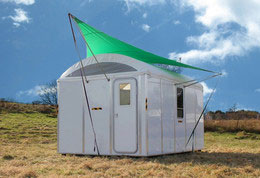Between wars and natural disasters, a startling 43 million people are displaced from their homes, many living in refugee camps, and that number will only grow with more extreme weather coming.
The United Nations High Commissioner for Refugees, which provides canvas tents for about 3.5 million people, asked Ikea – the king of inexpensive, sturdy, assemble-it-yourself furnishings – if it could come up with a better shelter.
Tents offer "little comfort, dignity, or security," says Per Heggenes, Ikea Foundation CEO. Since they have no insulation, they are cold in winter and hot in summer, have no electricity or lights, and last only about six months.
Ikea’s Design
True to form, Ikea’s structure arrives in four flat boxes and takes just four hours to assemble without any additional tools.
At 188 square feet, it is twice the size of a tent, providing a comfortable space for five people, and lasts three years or longer.

Laminated walls provide insulation and simply clip onto a steel frame. Made from a lightweight plastic, Rhulite, they were developed specifically for this purpose. It allows light to enter during the day, but not at night when people need privacy.
"A main problem in camps is that at night, light sources from inside tents cast shadows onto the walls of the people living inside them," Johan Karlsson, Project Manager at Refugee Housing Unit, which is manufacturing the components, told Fast Company. "In many locations this infringement on privacy is so strong that people prefer to live in the darkness, or even to abandon the tents when needing to use the light."
It also cuts the cost of building, assembling and shipping the 120-pound housing unit.
The shelter has to be light enough to be easily and cheaply transported and strong enough to withstand harsh conditions at refugee camps. "The design is to balance the mechanical properties such as UV, structural strength, insulation, cost and a very specific requirement for this application: privacy," Karlsson told Fast Company.
A sail-like metallic fabric attached to the roof provides the benefits of passive solar. During the day it keeps the inside cool, reflecting 70% of solar heat, and keeps it warm at night by sealing in the heat. A thin-film solar panel sits on top of the sail which provides energy for a light.
Other nifty features:
- the tough, rigid floor is actually the building’s crate. It unfolds to provide a secure, insulated base that’s raised off the ground, keeping insects and minor flooding at bay;
- a ventilated, fabric roof attaches easily and seals the building against weather;
- adjustable feet keep it off the ground and allow for uneven terrain;
Plans for a lockable door have so far been dropped because it adds too much to costs. They’d also like toad more solar capacity and a way to harvest pure water.
About 50 prototypes are currently being tested by Syrian refugees in Iraq and Lebanon and at a refugee camp in Ethiopia. Once they get feedback from the people who are using them, they will begin production this summer.
The UN plans to ship the shelters around the world as needed in conjunction with The Ikea Foundation, which also provides refugees solar lamps, education and drinking water. The partners hope to cut production costs from the current $7,000 per shelter to less than $1000 when they are built en masse.
Ikea is one of the most active corporations in the US on solar. It recently finished its 31th solar array on a store in Minnesota – the state’s largest – and is now using solar at 70% of US stores.
